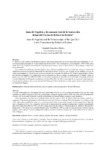Mostrar o rexistro simple do ítem
Juan de Segobia y los manuscritos de la traducción latina del Corán de Robert de Ketton
| dc.contributor.author | González-Muñoz, Fernando | |
| dc.date.accessioned | 2021-10-14T07:15:43Z | |
| dc.date.available | 2021-10-14T07:15:43Z | |
| dc.date.issued | 2021 | |
| dc.identifier.citation | González-Muñoz, F. «Juan De Segobia Y Los Manuscritos De La traducción Latina Del Corán De Robert De Ketton». Al-Qanṭara, vol. 42, n.º 1, julio de 2021, p. e07, doi:10.3989/alqantara.2021.007. | es_ES |
| dc.identifier.issn | 1988-2955e | |
| dc.identifier.issn | 0211-3589 | |
| dc.identifier.uri | http://hdl.handle.net/2183/28617 | |
| dc.description.abstract | [Resumen] El objetivo de este estudio es demostrar la estrecha relación que media entre dos de los manuscritos que actualmente se conservan de la traducción latina del Corán de Robert de Ketton (1142-1143), y la figura de Juan de Segobia (1390/5-1458), quien desde 1437 había estudiado esta versión del Corán hasta que él mismo, con la colaboración de un alfaquí hispano, elaboró una nueva traducción. Tras exponer las noticias que Juan de Segobia ofrece sobre los ejemplares del Corán latino que poseyó, se esboza una ordenación general de la tradición manuscrita del Alchoran de Robert de Ketton, que se divide en dos familias, α (la de los códices más antiguos) y β (la de los más recientes, derivados de un manuscrito traído en 1437 desde Constantinopla a Basilea por Johannes de Ragusio). La comparación entre la redacción que ofrece un grupo de manuscritos de la familia α (muy en particular, la del códice Paris BNF lat. 3393) con las variantes presentes en los códices de la familia β y en la propia edición de Theodor Bibliander (1543) permite concluir que el códice Paris BNF lat. 3669 es una copia de un manuscrito supervisado por Juan de Segobia, donde se ofrecía una redacción del Alchoran de Robert de Ketton revisada a partir de las variantes del códice de Johannes de Ragusio. | es_ES |
| dc.description.abstract | [Abstract] The aim of this paper is to demonstrate the close relationship between two of the extant manuscripts of the Qur’ān’s Latin translation by Robert of Ketton (1142-1143), and the figure of Juan de Segobia (1390/5-1458), who from 1437 had studied this version of the Koran until he himself, with the collaboration of a Spanish alfaquí, produced a new translation. After exposing the news that Juan de Segobia offers about the copies of the Latin Qur’ān that he possessed, a general arrangement of the manuscript tradition of the Alchoran by Robert of Ketton is outlined. This is divided into two families, α (that of the older codices) and β (that of the more recent ones, derived from a manuscript brought from Constantinople to Basel by John of Ragusio in 1437). The comparison between the wording offered by a group of manuscripts of family α (in particular that of the codex Paris BNF lat. 3393) with the variants present in the codices of family β and in the edition of Theodor Bibliander itself (1543) allows us to conclude that the codex Paris BNF lat. 3669 is a copy of a manuscript supervised by Juan de Segobia, which offered a revised wording of the Alchoran by Robert of Ketton based on the variants taken from the codex of John of Ragusio. | es_ES |
| dc.language.iso | spa | es_ES |
| dc.publisher | CSIC | es_ES |
| dc.relation.uri | https://doi.org/10.3989/alqantara.2021.007 | es_ES |
| dc.rights | Atribución 4.0 Internacional | es_ES |
| dc.rights.uri | http://creativecommons.org/licenses/by/3.0/es/ | * |
| dc.subject | Alchoran | es_ES |
| dc.subject | Ketton, Robert de | es_ES |
| dc.subject | Segobia, Juan de | es_ES |
| dc.subject | Tradición manuscrita | es_ES |
| dc.subject | Bibliander, Theodor | es_ES |
| dc.subject | Manuscript Tradition | es_ES |
| dc.title | Juan de Segobia y los manuscritos de la traducción latina del Corán de Robert de Ketton | es_ES |
| dc.title.alternative | Juan de Segobia and the Manuscripts of the Qur’ān’s Latin Translation by Robert of Ketton | es_ES |
| dc.type | info:eu-repo/semantics/article | es_ES |
| dc.rights.access | info:eu-repo/semantics/openAccess | es_ES |
| UDC.journalTitle | Al-Qanṭara | es_ES |
| UDC.volume | 42 | es_ES |
| UDC.issue | 1 | es_ES |
| UDC.startPage | 1 | es_ES |
| UDC.endPage | 18 | es_ES |
Ficheiros no ítem
Este ítem aparece na(s) seguinte(s) colección(s)
-
II - Artigos [662]






